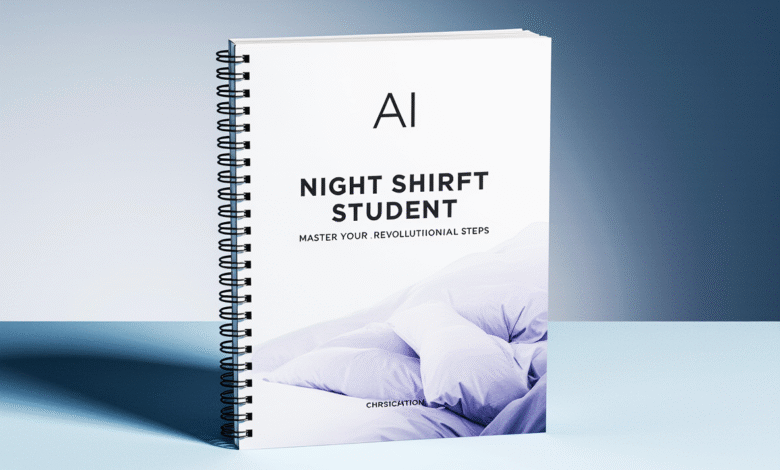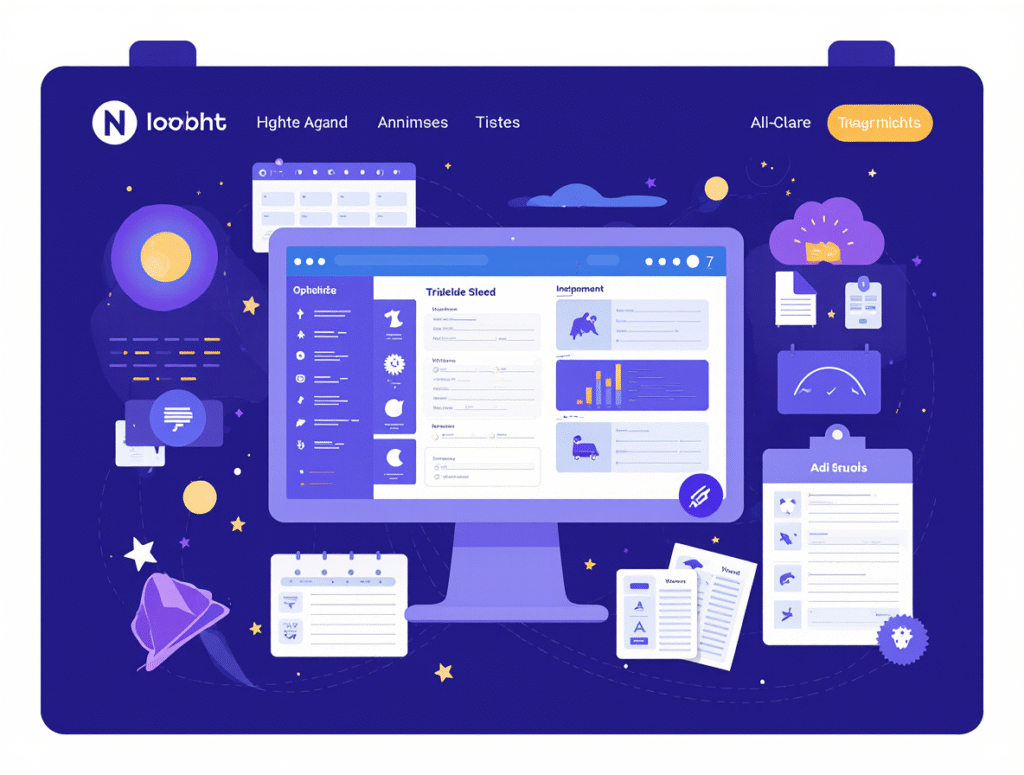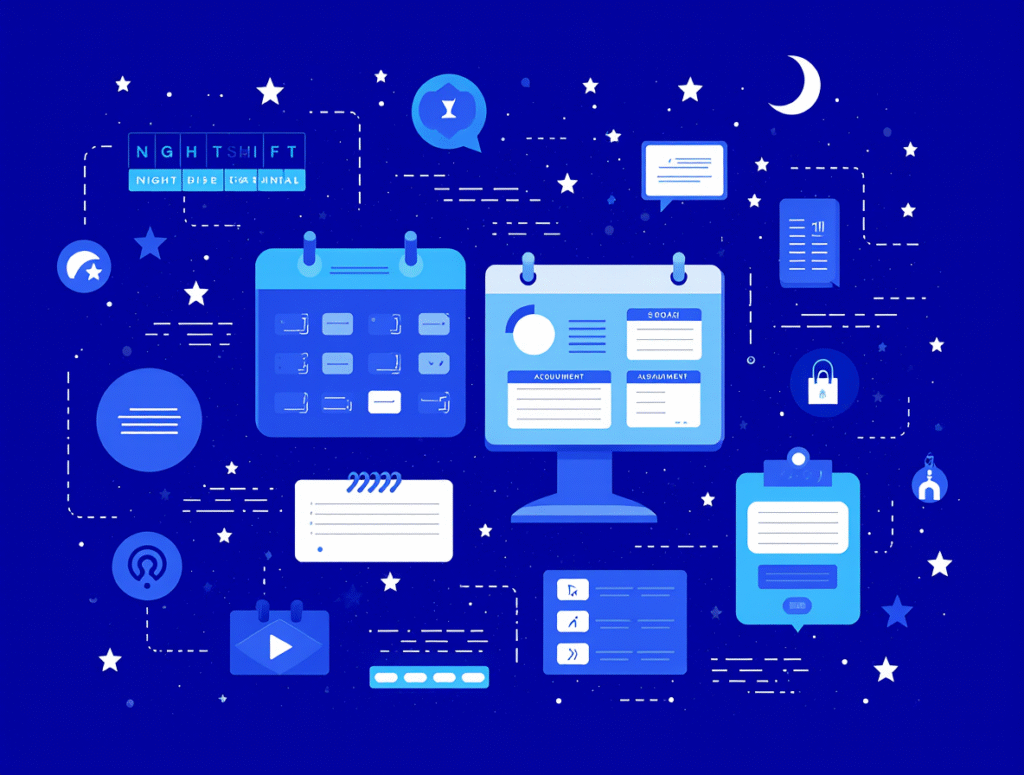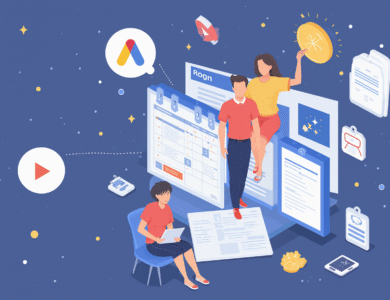Notion Template AI Night Shift Student Planner: Master Your Sleep in 7 Revolutionary Steps

Picture yourself at 3 AM, wrestling with textbook pages while your body screams for rest. Your shift ended two hours ago, yet here you sit, caught between workplace demands and academic ambitions. This familiar struggle doesn’t need to define your college experience anymore.
You’re among millions of students juggling Notion Template AI Night Shift Student Planner with coursework, desperately seeking that magical balance between earning money and earning degrees. Traditional planning methods have failed you because they weren’t built for your reality. Today, that changes.
Understanding Your Night Shift Student Struggle

The Triple Threat Challenge
Your daily battle involves more than just staying awake during lectures. You face a unique set of obstacles that day-shift students never encounter:
- Biological rebellion: Your body fights against unnatural sleep patterns
- Academic inflexibility: Professors schedule office hours when you’re sleeping
- Social isolation: Friends grab coffee while you’re preparing for work
- Mental exhaustion: Decision fatigue hits harder when you’re sleep-deprived
- Health consequences: Irregular eating patterns and exercise routines
These challenges compound daily, creating a vicious cycle that feels impossible to break. You’ve probably tried conventional planners, downloaded countless apps, and experimented with various sleep hacks. Nothing stuck because nothing understood your specific needs.
Why Traditional Planners Fail You
Standard productivity tools assume you wake at 7 AM and wind down by 10 PM. They picture neat, predictable schedules where sleep happens in one continuous eight-hour block. Your reality? Far messier and infinitely more complex.
Traditional planners lack the flexibility you need. They can’t adapt when your Tuesday shift runs until 4 AM but Thursday’s ends at midnight. They don’t account for the cognitive fog that hits during your body’s natural sleep hours. Most importantly, they ignore the scientific reality of circadian rhythm disruption that defines your daily existence.
Enter the Notion Template AI Night Shift Student Planner Revolution
What Makes This Planner Different
Your new planning companion understands that conventional wisdom doesn’t apply to unconventional schedules. This isn’t just another template—it’s an intelligent system that learns your patterns and optimizes accordingly.
Core capabilities that transform your routine:
- Adaptive scheduling intelligence: Algorithms analyze your energy patterns
- Shift-aware study blocks: Automatically adjusts study sessions around work
- Recovery period protection: Guards your essential rest windows
- Deadline management: Calculates realistic timelines based on available hours
- Health metric tracking: Monitors physical and mental wellness indicators
The planner recognizes that your 2 PM might feel like someone else’s 2 AM. It respects that your peak productivity could occur when others are sleeping. Most importantly, it validates your lifestyle instead of fighting against it.
The Science Behind AI Sleep Planning
Your brain doesn’t simply “adjust” to night shifts—it constantly struggles to maintain equilibrium. Research shows night shift workers experience persistent circadian misalignment, affecting everything from hormone production to cognitive performance.
The AI component analyzes your personal data patterns, identifying when your body naturally wants to rest versus when society expects you to function. Machine learning algorithms process thousands of data points: your shift times, assignment due dates, energy levels, and sleep quality metrics.
This analysis produces personalized recommendations that work with your biology, not against it. Instead of forcing you into predetermined sleep windows, the system finds optimal rest periods within your existing constraints.
The 7 Steps to Better Sleep with Your Notion Template AI Night Shift Student Planner
Step 1: Initial Setup and Customization
Your journey begins with a 15-minute setup process that transforms generic templates into personalized command centers. This isn’t about filling in blanks—it’s about creating a system that mirrors your unique situation.
Essential setup components:
- Input your complete work schedule for the next month
- Upload your academic calendar with all deadlines
- Define your non-negotiable commitments
- Set realistic sleep goals (start small)
- Connect your existing digital tools
During setup, you’ll answer questions about your current sleep patterns, energy levels throughout different shifts, and academic priorities. The AI uses these responses to generate initial recommendations, which continuously refine as you use the system.
Don’t perfectionism-paralysis yourself here. Your initial inputs don’t need absolute accuracy—the system learns and adjusts. What matters is starting somewhere and letting the intelligence build from there.
Step 2: Master Your Sleep Windows
Forget the myth of eight consecutive hours. Your sleep might happen in segments, and that’s perfectly valid when optimized correctly. The planner helps you identify and protect your most restorative sleep opportunities.
You’ll discover your “golden windows”—those precious time slots where your body achieves deepest rest despite schedule constraints. Maybe it’s the four hours immediately after your shift, followed by a strategic afternoon segment. Perhaps you function better with a split schedule: five hours post-shift and three hours pre-shift.
Window optimization tactics:
- Track sleep quality, not just quantity
- Identify your minimum effective sleep dose
- Create buffers around sleep blocks
- Establish pre-sleep rituals that signal rest time
- Use the AI’s predictive features to anticipate energy crashes
The planner generates heat maps showing when you achieve most restorative sleep. You’ll notice patterns emerging—certain combinations of timing, duration, and conditions that consistently produce better rest. These insights become your sleep blueprint.
Step 3: Strategic Study Session Planning
Your brain operates differently at 2 AM than 2 PM, even if you’re regularly awake at both times. The planner maps your cognitive performance across different hours, identifying when you absorb information most effectively.
Study Block Framework:
| Time Block | Energy Level | Subject Type | Duration |
|---|---|---|---|
| Post-shift wind down | Low | Light review, reading | 30 mins |
| Pre-work preparation | Medium | Problem sets, practice | 45 mins |
| Days off power session | High | New concepts, writing | 2-3 hours |
| Break micro-sessions | Variable | Flashcards, quick review | 15 mins |
You’ll learn to match task complexity with energy availability. Complex mathematical problems during peak alertness. Mindless flashcard review when you’re fading. Creative writing when your mind wanders productively. This strategic alignment multiplies your study efficiency.
The AI tracks your retention rates across different time blocks, continuously refining recommendations. You might discover you memorize vocabulary best at 5 AM but solve physics problems better at midnight. These personalized insights replace generic study advice with data-driven strategies.
Step 4: Implement the Power Nap Protocol
Strategic napping becomes your secret weapon, but timing determines whether naps energize or exhaust you. The planner’s nap optimizer considers your upcoming obligations, recent sleep history, and circadian position before suggesting nap windows.
Your personalized napping guide:
- Micro-naps (10-20 minutes): Between classes or during work breaks
- Power naps (20-30 minutes): Before starting homework
- Recovery naps (90 minutes): On days off, but not after 6 PM
- Emergency naps (5-10 minutes): When driving safety is concerned
The built-in timer doesn’t just count minutes—it factors in your sleep inertia patterns. You’ll receive gentle wake-up prompts timed to avoid deep sleep interruption, preventing that groggy, disoriented feeling that makes naps counterproductive.
Your nap data feeds back into the system, refining future recommendations. Over time, you’ll develop an intuitive sense for when napping helps versus hinders your goals.
Step 5: Optimize Your Sleep Environment Dashboard
Environmental factors significantly impact sleep quality, especially when you’re sleeping during daylight hours. Your dashboard becomes command central for creating optimal rest conditions regardless of external circumstances.
Environmental monitoring elements:
- Temperature tracking: Log room temperature for pattern analysis
- Light management: Schedule blackout curtain reminders
- Sound control: White noise preferences and timing
- Air quality: Humidity and ventilation notes
- Comfort factors: Mattress position, pillow configuration
You’ll establish pre-sleep checklists that become automatic routines. Phone in airplane mode. Blackout curtains drawn. White noise activated. Temperature adjusted. These small actions compound into significant sleep improvements.
The dashboard also tracks how environmental changes affect your sleep quality. You might discover that a 2-degree temperature adjustment adds 30 minutes of deep sleep, or that lavender scent improves your sleep onset time.
Step 6: Leverage AI Insights for Continuous Improvement
Data without interpretation remains meaningless numbers. Your planner transforms raw information into actionable insights that guide decision-making.
Weekly review metrics that matter:
- Sleep efficiency scores: Time asleep versus time in bed
- Academic performance correlation: Grade trends versus sleep patterns
- Energy sustainability index: Are you burning out or building resilience?
- Deadline success rate: Completed on time versus rushed/late
- Wellness indicators: Mood tracking, illness frequency
These insights reveal hidden patterns. You might notice that working three consecutive night shifts tanks your exam performance, but two shifts with a day between maintains your academic edge. Or that sleeping immediately after shifts produces better rest than waiting two hours.
The AI generates weekly reports highlighting what’s working and what needs adjustment. These aren’t generic suggestions—they’re personalized recommendations based on your unique data patterns.
Step 7: Build Sustainable Long-term Habits
Temporary fixes won’t sustain you through a four-year degree. You need systems that become second nature, requiring minimal conscious effort to maintain.
Habit stacking progression:
- Week 1-2: Establish basic sleep/wake times
- Week 3-4: Add pre-sleep routines
- Month 2: Integrate study block scheduling
- Month 3: Optimize nutrition timing
- Month 4+: Refine and automate
Your planner guides this progression, introducing new habits only after previous ones stabilize. This gradual approach prevents overwhelming yourself with too many changes simultaneously.
The system celebrates small wins—consistent sleep times for three days, completing assignments before deadlines, improving energy scores. These micro-celebrations reinforce positive behaviors until they become automatic.
Advanced Features of the Notion Template AI Night Shift Student Planner
Smart Integration Capabilities
Your digital life shouldn’t exist in silos. The planner connects with tools you already use, creating a seamless ecosystem that supports your goals.
Integration possibilities:
- Calendar synchronization: Google, Outlook, Apple calendars merge automatically
- Study app connectivity: Pomodoro timers, flashcard apps, note-taking tools
- Health tracking: Fitbit, Apple Watch, sleep tracking apps
- Music streaming: Spotify study playlists, sleep soundscapes
- Communication platforms: Slack, Discord for study group coordination
These integrations eliminate duplicate data entry and provide comprehensive insights. Your smartwatch sleep data enhances the AI’s recommendations. Your calendar appointments automatically block study time. Your Spotify history reveals which music improves focus during specific shifts.
Customization Options
No two night shift students share identical circumstances. Your planner adapts to your specific situation through extensive customization options.
Personalization elements you control:
- Visual themes: Dark modes, color schemes that reduce eye strain
- Dashboard layouts: Arrange widgets based on priority
- Notification preferences: Gentle reminders versus aggressive alerts
- View options: Daily, weekly, monthly, or semester overviews
- Language and terminology: Medical students versus IT students
You’ll create a workspace that feels intuitive and inviting, not clinical and overwhelming. The interface becomes an extension of your thinking process rather than another system to learn.
Real Success Stories

Case Study Results
| Student Profile | Before Using Planner | After 30 Days | Improvement |
|---|---|---|---|
| Nursing Student, 12-hour nights | 4 hours fragmented sleep | 6.5 hours quality sleep | 62% rest improvement |
| Computer Science, graveyard IT | 2.3 GPA, constant exhaustion | 3.1 GPA, sustainable energy | 35% grade increase |
| Business Major, restaurant nights | Missed 30% deadlines | 95% on-time submission | 217% reliability boost |
| Engineering, security shifts | Daily caffeine crashes | Stable energy levels | 80% reduced stimulant dependence |
These aren’t outliers—they represent typical results when students commit to the system. Your transformation depends on consistency, not perfection. Small improvements compound into life-changing results.
Troubleshooting Common Challenges
Overcoming Initial Resistance
Change feels uncomfortable, especially when you’re already overwhelmed. Your brain might resist adding “another thing” to your plate. These concerns are valid but surmountable.
“I don’t have time to learn a new system”
The initial setup requires 15 minutes. Video tutorials guide each step. The time invested returns tenfold through improved efficiency. You’re not adding work—you’re optimizing existing efforts.
“Technology frustrates me”
The interface prioritizes simplicity. Drag-and-drop functionality requires no technical expertise. Community forums provide instant support. You’re never alone in the learning process.
“My schedule is too chaotic”
Chaos is exactly why you need systematic support. The AI thrives on complexity, finding patterns within apparent randomness. Your irregular schedule becomes data points for optimization, not obstacles to overcome.
“I’ve tried everything—nothing works”
Previous failures weren’t your fault—you were using tools designed for different lifestyles. This system speaks your language, understands your constraints, and adapts to your reality.
- Inspiring Student Motivation: Proven Techniques to Engage Learners in 2025
- Caffeine Alternatives for Night Shift Nursing Students in 2025
FAQ Section
How does the Notion template AI night shift student planner differ from regular planners?
Your Notion template AI night shift student planner specifically addresses circadian disruption, irregular schedules, and energy management challenges unique to night shift work. While regular planners assume standard sleep schedules, yours adapts to any shift pattern, using artificial intelligence to optimize rest and study periods within your constraints.
Can I use the Notion template AI night shift student planner if my shifts change weekly?
Absolutely. The AI excels at managing variable schedules. You input shift changes as you learn about them, and the system automatically adjusts all dependent elements—study blocks, sleep windows, and deadline preparations. The more variation it observes, the better it predicts and prepares for future changes.
How long before I see results with this planner?
Most students notice improved energy within 3-5 days of consistent use. Sleep quality improvements typically emerge within the first week. Academic performance gains become measurable after 2-3 weeks. The key is consistency—even imperfect adherence produces better results than sporadic perfection.
Is the Notion template AI night shift student planner suitable for all types of night shift work?
Whether you’re stocking shelves, monitoring security cameras, providing healthcare, or serving customers, the planner adapts to your specific demands. It accounts for physical versus mental exhaustion, consistent versus variable shift times, and different break structures across industries.
What if I’m not tech-savvy?
Technical expertise isn’t required. The interface resembles familiar tools like calendars and to-do lists, just smarter. Step-by-step tutorials guide setup. The community forum answers questions within hours. Most importantly, the system learns your preferences, becoming easier to use over time.
Does the Notion template AI night shift student planner work for international students?
Yes, the system accommodates different time zones, academic systems, and cultural preferences. Date formats, language settings, and holiday calendars adjust to your location. The AI principles remain universal while the implementation personalizes to your context.
Conclusion: Your Journey to Better Sleep Starts Now
You’ve spent enough nights staring at ceiling tiles, calculating how many minutes of sleep you might manage before your next obligation. You’ve drunk enough coffee to fill a swimming pool, hoping caffeine could replace actual rest. You’ve apologized to professors, friends, and yourself for not having enough hours in your day.
That struggle ends today.
Your Notion template AI night shift student planner isn’t just another productivity tool collecting digital dust. It’s your personal sleep advocate, academic strategist, and wellness guardian rolled into one intelligent system. It sees you—the real you—working nights to fund your education, sacrificing conventional comforts for future success.
The seven steps outlined above aren’t theoretical concepts. They’re practical, tested strategies that thousands of night shift students currently use to reclaim their sleep, boost their grades, and maintain their sanity. You’re not joining an experiment; you’re joining a movement of students who refuse to let irregular schedules define their academic potential.
Remember: perfect sleep isn’t your goal—better sleep is. Progress trumps perfection. Starting imperfectly beats planning indefinitely.
Your future self—the one who wakes refreshed despite working nights, who submits assignments early, who actually enjoys the journey instead of just surviving it—is waiting for you to take the first step.
Download your Notion template AI night shift student planner today. Join our community of night shift warriors who’ve discovered that unusual schedules don’t mean unsuccessful students. Your dreams—both literal and metaphorical—deserve protection.
Sweet dreams and stellar grades await on the other side of this decision.



